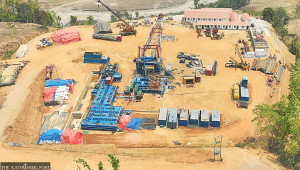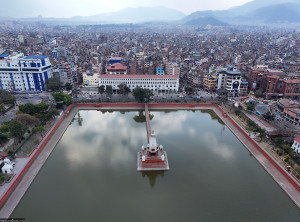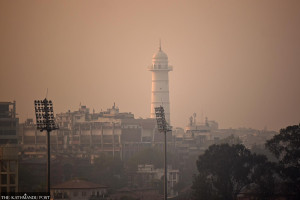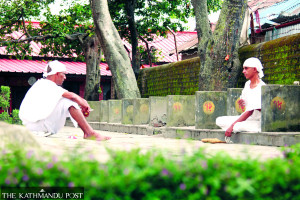Opinion
Everest’s orphans
In the absence of a strong welfare system, there is a need to address families where the breadwinner is lost
Helen Sherpa
The little girl was sobbing hysterically and had soiled her pants. She struggled as teachers held her tight, trying desperately to calm her down. The teachers explained that a few weeks ago her father had died on Everest and that his climber clients were sponsoring her to come to this boarding school in Kathmandu. She was just four years old, her cheeks still a rosy red from the cold of Khumbu, and would be going into kindergarten class. As I looked around the grim boarding school with its high-rise classroom blocks, cramped dormitories and tiny concrete playground, I thought of her beautiful village of Phurte with its squat unpretentious stupa encircled by snow-clad peaks. Could being torn from her mother and community so soon after her father’s death really be the best option for this young girl?
The recent tragedy on Mt Everest has left another 32 fatherless, ranging from adults to the youngest, who was only two weeks old on the day of the avalanche. Again, well-intentioned climbers and other sponsors are coming forward to help support these children. Often the fathers’ highest priority was to educate their children, to spare them becoming climbers themselves and taking such risks, so the sponsors also want to focus on paying for education. However, little thought is given to what form of support is in the best interests of the child. Should the child stay with their mother, grandparents, uncles, aunts and cousins in the village and attend the local school? Or will the child be better off torn away and rushed into a Kathmandu boarding school? At what age should a child go to boarding school, if at all? Can they be supported at the village schools first and later get help for Plus Two or university?
Boarding schools best?
Currently, little consideration is given to the age at which the child is sent to boarding school and the psychosocial trauma that results. Medical studies from around the world show that sending young children to boarding school can result child abuse and trauma. While cases of physical and sexual abuse in institutions such as boarding schools and children’s homes are well documented in the West, in Nepal, there is still denial as to the scale of the problem. The long-term impacts of emotional deprivation, alienation from culture and family are less visible. Still, international studies have shown that even seemingly socially successful boarding school graduates can be hiding difficulties forming intimate relationships with serious consequences in adult life.
Nepali families have been convinced that Kathmandu’s boarding schools must be the best option because they generally have the best exams results at the high school level. The results from elite private schools are admirable, but too often sponsored children are placed in the cheaper boarding schools where standards are much lower and the hostel facilities are poor. When children come from the village, they are often automatically forced into lower grades on the excuse that their village education could not possibly match the boarding school standards, causing further trauma.
Donor fatigue
While the tragedy is fresh and the children are young and cute, the donors are committed; but as the years go by, the costs increase and donors get fatigued with the constant requests for fees, uniforms, transport for holiday trips home and other costs. Many stop their funding and right in the final years of schooling, when the costs are the highest, widows find themselves struggling alone to meet children’s expectations. Donors and sponsors are also often unwilling to consider financially supporting village schools or waiting to meet the costs of high school, university or vocational training instead.
The financial costs are not the only issue; removing so many children from remote mountain schools undermines their viability, making it difficult to retain teachers. As more children go to boarding schools, the pressure on the remaining families to also send their children increases until the local schools and villages empty.
Counselling families
Unfortunately, Nepal has very few social workers capable of counselling newly bereaved widows. In the first emotional weeks, they are often pushed to agree to children being placed in boarding schools or far away children’s homes. Once removed from the family, who is watching out for these children? Boarding schools, like all businesses, aim to maximise profits. Many families and sponsors have found children are poorly cared for and given inappropriate medical care when sick. Even less attention is paid to their psychosocial care and maintaining family relationships and a connection with their culture. Many schools do not even have systems in place requiring a designated guardian close by to keep in contact with in case of emergencies.
This year the focus is on the Sherpa community and the families of climbers, but during the ‘People’s War’ many widows were in a similar position. In some districts, they were supported with counselling, school scholarships and help to start businesses or improve livelihoods, and most were able to keep their families together. However, in places where such support was not provided, many children were removed to ‘orphanages’.
In the absence of a strong national social welfare system, there will be an ongoing need in Nepal to address young families where the main breadwinner is lost. Simply raising money is not enough. Migrant workers have contributed huge amounts to the Migrant Workers’ Welfare Fund, but still no proper mechanisms are in place to support their surviving children, spouses and aging parents. There is not even any representation from the migrants themselves in the decision-making processes for the Fund. Business associations and most government agencies currently lack the capacity to manage welfare programs and need to partner with NGOs capable of mobilising a child protection officer who can work with the family to assess education options and other support mechanisms to find paths that are in the best interests of the children.
As the Nepal Government, the Nepal Mountaineering Association, foreign climbers and the Sherpa community grapple with how to best support these mountaineers’ families, they need to learn from experiences around the world. Simply placing children in institutions for years on end poses major risks. The experience of Australia’s Aborigines, Native Americans in the US and Canada, Irish orphans and many others show the dangers of such blind faith in institutionalised education. If these climbers’ children are not to be Nepal’s ‘lost generation’, more considered approaches are needed.
Sherpa is Nepal Country Director of World Education




 24.26°C Kathmandu
24.26°C Kathmandu










